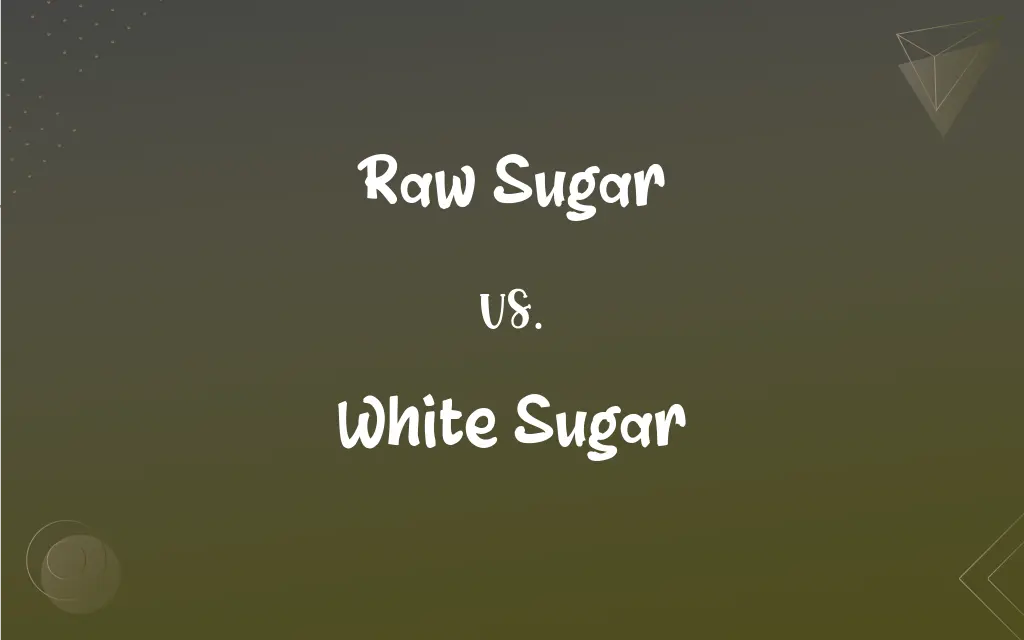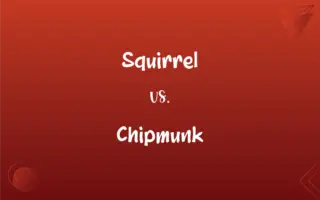Raw Sugar vs. White Sugar: What's the Difference?
Edited by Aimie Carlson || By Harlon Moss || Updated on October 23, 2023
Raw sugar is minimally processed sugar with a golden hue; white sugar is refined sugar stripped of molasses.

Key Differences
Raw sugar and white sugar are both derived from sugar cane or sugar beet plants, but they undergo distinct processes that influence their texture, flavor, and color. Raw sugar is extracted directly from the juice of the sugar cane, then crystallized and left with some molasses content. This results in its coarse texture and golden-brown color. On the contrary, white sugar undergoes additional refining stages, eliminating all molasses, leaving pure sucrose crystals.
In terms of flavor, raw sugar possesses a subtle caramel-like taste due to the retained molasses. White sugar, with its pure sucrose content, offers a straightforward sweetness with no accompanying flavors. For those keen on a more nuanced, earthy sweetness, raw sugar might be more appealing. However, for a consistent and clear sweetening effect, white sugar might be preferable.
Nutritionally, the differences between raw sugar and white sugar are negligible. Though raw sugar retains some minerals from molasses, these amounts are often too minute to make a significant dietary impact. White sugar, in its refined form, primarily delivers empty calories without beneficial nutrients.
For culinary applications, raw sugar and white sugar can sometimes be used interchangeably, but nuances in flavor and texture might affect the final product. Raw sugar's coarser grains might not dissolve as readily as white sugar's fine crystals. Additionally, raw sugar might impart its distinct hue and taste to dishes, which could be desirable in some recipes and not in others.
In summation, while both raw sugar and white sugar serve as sweetening agents, they differ in processing, flavor, nutrition, and culinary behavior. The choice between them often hinges on the desired taste, texture, and appearance of the dish or beverage.
ADVERTISEMENT
Comparison Chart
Processing
Minimally processed, retains some molasses.
Fully refined, molasses removed.
Flavor
Slight caramel-like due to molasses.
Pure sweetness.
Nutritional Content
Traces of minerals from molasses.
Mostly empty calories; no molasses minerals.
Texture and Appearance
Coarser grains, golden hue.
Fine crystals, pure white.
Use in Cooking
Might not dissolve as readily, impacts color/flavor.
Dissolves easily, consistent sweetness.
ADVERTISEMENT
Raw Sugar and White Sugar Definitions
Raw Sugar
Sugar minimally processed, retaining some molasses.
The cookie recipe called for raw sugar to give it a richer flavor.
White Sugar
Often termed "table sugar" or "granulated sugar."
He reached for the white sugar, also labeled granulated, for his recipe.
Raw Sugar
Less refined than white sugar, with a distinct flavor.
The cake baked with raw sugar had a delightful hint of molasses.
White Sugar
Fine crystals, offering a consistent sweetness.
She stirred a teaspoon of white sugar into her morning coffee.
Raw Sugar
Often termed "turbinado" or "demerara" in stores.
The store shelf had various brands of raw sugar labeled as demerara.
White Sugar
Ubiquitous in baking and cooking for its predictability.
For the frosting, he used white sugar to ensure a smooth texture.
Raw Sugar
Coarse, golden-brown sugar crystals.
He sprinkled raw sugar on his oatmeal for added texture.
White Sugar
Refined sugar with all molasses content removed.
White sugar dissolved quickly in her iced tea.
Raw Sugar
Sugar extracted directly from sugar cane juice.
She prefers raw sugar in her coffee for its subtle caramel notes.
White Sugar
Composed of pure sucrose crystals.
The recipe specified white sugar for a clear and pure sweetness.
FAQs
Can I use raw sugar in place of white sugar in recipes?
Generally, yes, but it might alter the texture, color, and flavor of the final product.
Is white sugar more processed than raw sugar?
Yes, white sugar undergoes additional refining steps to remove molasses.
Which sugar dissolves faster?
White sugar, due to its fine crystals, typically dissolves quicker than raw sugar.
Are there different types of raw sugar?
Yes, including turbinado and demerara, which vary slightly in crystal size and molasses content.
Is raw sugar healthier than white sugar?
Both are primarily empty calories, but raw sugar retains trace minerals from molasses.
How is white sugar made?
It's derived from sugar cane/beet juice, refined to remove molasses and impurities.
Is raw sugar less sweet than white sugar?
Both offer comparable sweetness, but raw sugar has additional flavor notes from molasses.
Can raw sugar be used in candy-making?
It can, but its molasses content might influence the candy's final color and taste.
What is caster sugar?
It's a finer version of white sugar, often used in baking for its quick-dissolving properties.
Is powdered sugar the same as white sugar?
No, powdered sugar is white sugar ground to a powdery consistency, often with added cornstarch.
Which is sweeter, raw sugar or white sugar?
Both are comparably sweet, but raw sugar has a caramel undertone from molasses.
Is raw sugar the same as brown sugar?
No, brown sugar is white sugar with molasses added back, while raw sugar naturally retains some molasses.
Do both sugars have the same calorie count?
Yes, both have similar calorie content per gram.
Why is white sugar used more commonly in baking?
Its consistent texture and pure sweetness make it predictable in recipes.
Are there any ethical concerns related to sugar production?
Yes, some raise concerns about labor practices and environmental impacts in sugar production.
Are there any health benefits to using raw sugar over white sugar?
While raw sugar has trace minerals from molasses, the difference is often negligible health-wise.
Does raw sugar have a longer shelf life than white sugar?
Both sugars have long shelf lives, but storage conditions can affect their texture over time.
What gives white sugar its pure white color?
The complete removal of molasses and impurities during refining.
Why is raw sugar sometimes brown?
The brown hue is due to retained molasses content.
Why do some recipes specifically ask for raw sugar?
It can impart a distinct color, texture, and flavor to dishes.
About Author
Written by
Harlon MossHarlon is a seasoned quality moderator and accomplished content writer for Difference Wiki. An alumnus of the prestigious University of California, he earned his degree in Computer Science. Leveraging his academic background, Harlon brings a meticulous and informed perspective to his work, ensuring content accuracy and excellence.
Edited by
Aimie CarlsonAimie Carlson, holding a master's degree in English literature, is a fervent English language enthusiast. She lends her writing talents to Difference Wiki, a prominent website that specializes in comparisons, offering readers insightful analyses that both captivate and inform.































































